| Thumbnails - press to get the full resolution |
|
File size |
|
Country / place
|
|
Text |

|
|
66,8 kb |
|
Italy, Vatican-museum, Rome |
|
There is a hammer to be seen on the left of the relief. The hammer must be involved in the reconstruction, but how?
Take a look in Google for: History of Collar Harnessing in Source Pictures.
|

|
|
32,7 kb |
|
Italy, Vatican-museum, Rome |
|
This type of mill has many names. Conical mill. Pompeii mill. Donkey mill. Hourglass shaped mill. Form of a double funnel mill. Animal mill. Quern mill. Grain mill. Pistrinum (mill).
The term quern, should not be used.
|

|
|
233 kb |
|
Villa Medici, Rome.
DAI, photo
|
|
Here the horse is walking the wrong way. It should walk against the sun.
At top the funnel for the corn, then the upper stone called the meta (in Latin) and the lover stone called the catillus.
How the horse is harnessed to the meta is not easy to see.
|
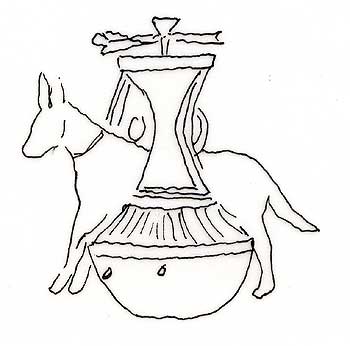
|
|
48,7 kb |
|
Italy.
Naples Museum
|
|
This terracotta is lost. |

|
|
90,8 kb |
|
Italy.
Naples Museum
|
|
This small relief was to be seen in the handle of an oil lamp.
Same as the previous image. There are more of these reliefs, but they are difficult to find.
Some are in: Gerhard Zimmer: Römische Berufdarstellungen. DAI, Berlin 1982.
L.A. Moritz: Grain-Mills and Flour in Classical Antiquity. Oxford, 1958
|

|
|
37,5 kb |
|
France, Narbonne |
|
See picture from Noctes Gallicanae (French) |
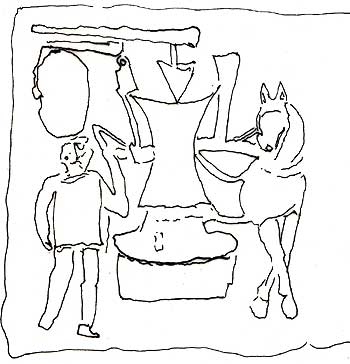
|
|
93,6 kb |
|
Italy,
Ostia Antica
|
|
This is a relief found in the necropolis of Ostia.
It is in the museum.
|

|
|
199 kb |
|
Algeria |
|
A complete mill-construction, to be found in a French-Algerian journal. |

|
|
58,6 kb |
|
Israel |
|
|

|
|
187 kb |
|
Italy
Ostia Antica
|
|
The Internet Google Images has many pictures like my photo here taken in the 1970s.
Try Google, Image: Molino I, XIII, 4
Try also: Mills in hall 8a.
|

|
|
60,7 kb |
|
Syria, Museum in Damascus |
|
One of the many hourglass shaped mills exhibited in the yard of the museum. |

|
|
124 kb |
|
Syria Museum in Damascus |
|
Another of the many mills in Damascus. |

|
|
118 kb |
|
Israel |
|
A very small flourmill. |

|
|
68,1 kb |
|
Syria Museum in Damascus |
|
A typical grain mill. |

|
|
69,4 kb |
|
Syria Museum in Damascus |
|
Another mill in the Damascus museum. |

|
|
26 kb |
|
Millstone without prove-nance |
|
The hole with the white rim is the results from excessive wear. |

|
|
108 kb |
|
Syria Museum in Damascus |
|
Mill but exhibited upside down. |

|
|
|
|
Israel. In the museum near the dam at Ma’agan Michael. |
|
This unpublished stone is inside shaped like an hourglass mill. |

|
|
48,8 kb |
|
Israel. In the museum near the dam at Ma’agan Michael. |
|
The same mill as the previous stone. |
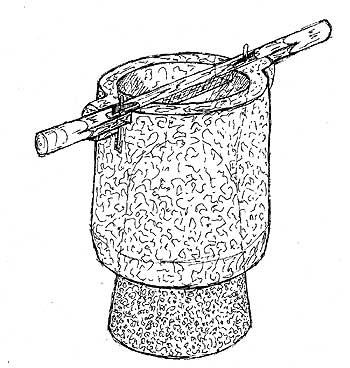
|
|
153 kb |
|
Israel. In the museum near the dam at Ma’agan Michael. |
|
Reconstruction of the hourglass shaped mill from Ma’agan Michael. |

|
|
119 kb |
|
Israel. In the museum near the dam at Ma’agan Michael. |
|
Section of the mill in the previous drawing. |

|
|
83,5 kb |
|
Germany |
|
This is probably the first unsuccessful attempt to make a reconstruction of a Pompeian donkey mill. |

|
|
70 kb |
|
Germany |
|
The front-page of the book in which the first reconstruction appear. Printed in 1833.
See the drawing above.
Still in 2007 a proper reconstruction is lacking.
|

|
|
114 kb |
|
Denmark. Statens Museum for Kunst.
Carl BLOCH.
|
|
This - in Denmark - famous painting is made in Rome in 1863.
It is Samson who turns the mill. Unfortunately the painter has forgotten that the upper stone has to be elevated about a millimetre, if Samson should turn it.
No copyright according to Danish Copyright Act §23,3
|
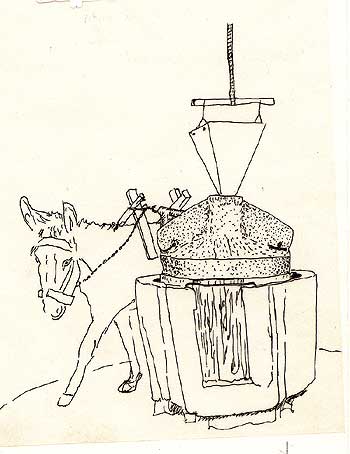
|
|
87,9 kb |
|
Italy, Sardinia |
|
This drawing is based on an old photo from Sardinia. This is an indoor construction.
Perhaps the millstones are conical, but it is not an hourglass shaped mill.
The depicted mil was still in use up to 1950s.
|
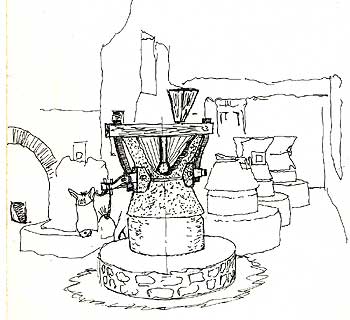
|
|
100 kb |
|
Italy, Ostia |
|
Reconstruction based on the mills in Pompeii and the Sardinian donkey-mill.
This my reconstruction of the harnessing of the donkey is not the final solution.
On Internet you will find a great many photos of precisely this mill but without the donkey.
|

|
|
144 kb |
|
Germany |
|
This reconstruction is to be found in a German museum.
There is also one in EUR Rome Museo Civilta Romana and one in Chemtou in Tunisia close to Algeria.
|

|
|
74,2 kb |
|
Tunisia. Near Carthage. |
|
This is an exceptional construction. Even the mainlines of the wooden framework for this mill is not easy to reconstruct. |

|
|
144 kb |
|
Algeria. Near the town Algeria. |
|
Most museums for archaeology have a yard in which they store the conical millstones.
Most of them are worn out. Already in Roman time they were used as filling.
|
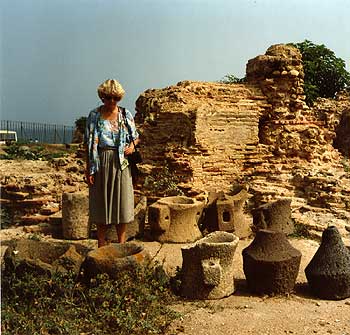
|
|
143 kb |
|
Algeria. Near the town Algeria. |
|
Nearly the same spot as in the previous picture, but here we could see that the stones are very small.
Perhaps children turned them but let us hope they were not?
Even for a donkey it is hard work.
|





























